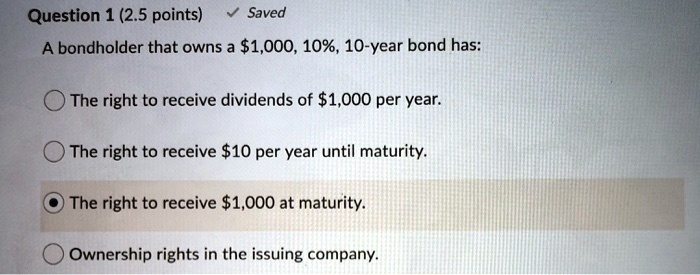A bondholder that owns a 1,000,10- year bond has:

The Correct Answer and Explanation is:
The correct answer is: The right to receive $1,000 at maturity.
Explanation:
A 10%, 10‑year bond with a $1,000 face value means two distinct components of the bondholder’s cash flows:
- Annual coupon payments:
Since the coupon rate is 10%, the bond pays 10% of $1,000 each year, which means $100 annually. This continues for the entire 10-year term. - Principal repayment at maturity:
At the end of the 10 years, the issuer returns the $1,000 face value to the bondholder.
Now let’s look at each option and why only the third one is correct:
- “The right to receive dividends of $1,000 per year.”
Bonds do not pay dividends—dividends come from equity (stocks), not debt. So this is incorrect. - “The right to receive $10 per year until maturity.”
That figure is far too low. A 10% coupon on $1,000 pays $100 per year, not $10. Thus, this statement is also incorrect. - “The right to receive $1,000 at maturity.”
This is accurate because it refers to the repayment of the bond’s face value at the end of its term. While bondholders also get annual interest payments, none of the other answer choices mention coupons. Therefore, the only statement that is factually correct among the provided options is that the bondholder has the right to receive the full principal amount ($1,000) when the bond matures. - “Ownership rights in the issuing company.”
Bonds are debt instruments. Owning a bond does not grant any ownership rights, control, or voting privileges in the issuing firm. Those rights are reserved for shareholders.
In summary, the bondholder does indeed get $100 in interest annually and $1,000 in principal at maturity. Since the question’s options only correctly state one of these entitlements, the option about receiving $1,000 at maturity is the only correct choice.
